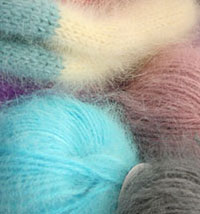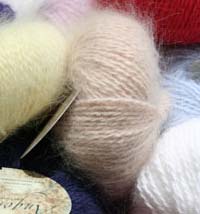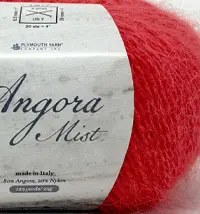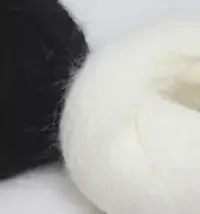ANGORA YARN
Please note—not all Angora is the same—our French Angora, Belangora, is THE authentic Belangor™ French Angora! This decadent luxury fiber comes in a variety of gorgeous, luminous shades—extremely warm, this lighter than air yarn feels sumptuous against the skin, and is a favorite for cowls, hats, mittens and scarves. Galler Yarns has imported this yarn continuously since 1951. In 2013 this pure natural yarn, made from fibre hand-combed from carefully tended Angora rabbits, was officially designated as an Artisan Product in France.
The story of angora Yarn
Angora wool or Angora fiber refers to the downy coat produced by the Angora rabbit. While their names are similar, Angora fiber is distinct from mohair, which comes from the Angora goat. Angora fiber is also distinct from cashmere, which comes from the cashmere goat. Angora is known for its softness, thin fibers, and what knitters refer to as a halo (fluffiness). It is also known for its silky texture. It is much warmer and lighter than wool due to the hollow core of the angora fiber. It also gives them their characteristic floating feel.
Angora rabbits produce coats in a variety of colors, from white through tan, gray, and brown to black. Good quality Angora fiber is around 12-16 micrometres in diameter, and can cost around $10-16 per ounce (35-50 cents/gram). It felts very easily, even on the animal itself if it is not groomed frequently.
Yarns of 100% angora are typically used as accents. They are quite striking, visually appearing and to the touch feeling, similar to fur. They have the most halo and warmth, but can felt very easily through abrasion and humidity and can be excessively warm in a finished garment. The fiber is normally blended with wool to give the yarn elasticity, as Angora fiber is not naturally elastic. The blend decreases the softness and halo as well as the price of the finished object. Commercial knitting yarns typically use 30-50% angora, in order to produce some halo, warmth, and softness without the side effects of excessive felting.
How many kinds of Angora rabbits are there?
There are four different ARBA recognized types of Angora rabbit: English, French, Satin and Giant. There are many other breeds, one of the more common being German. Each breed produces different quality and quantity of fiber, and has a different range of colors.
Where is most Angora Produced?
Angora fur is produced in Europe, Chile, China and the United States. Harvesting occurs up to three times a year (about every 4 months) and is collected by plucking, shearing, or collection of the molting fur.
Most breeds of Angora rabbits molt with their natural growth cycle about every four months. Many producers of the fiber pluck the fur of these breeds. Plucking is, in effect, pulling out the molted fur. Plucking ensures a minimum of guard hair, and the fur is not as matted when plucked as when it is collected from the rabbit's cage. However, plucking a rabbit is time consuming, so some producers shear the rabbit instead. While this results in slightly lower quality fleece, as the guard hairs are included, it does take less time and results in more fleece. Also, not all breeds of Angora molt, and if the rabbit does not naturally molt, it cannot be plucked. German Angoras do not molt.
The rabbits must be groomed at least once or twice a week to prevent the fur from matting and felting. There is also a danger a rabbit will ingest its own molted fur; unlike a cat, a rabbit cannot easily be rid of the build up.
What areas of the Angora Rabbit does most of the fiber come from?
The premium first quality wool is taken from the back and upper sides of the rabbit. This is usually the longest and cleanest fiber on the rabbit. There should not be hay or vegetable matter in the fiber. Second quality is from the neck and lower sides, and may have some vegetable matter. Third quality is the buttocks and legs and any other areas that easily felt and are of shorter length. Fourth quality is totally unsalvageable, and consists of the larger felted bits or stained fiber. Third and fourth quality are perfect for cutting up for the birds to use in lining their nests. With daily brushing, felting of the fiber can be avoided, increasing the usable portion of fiber.




